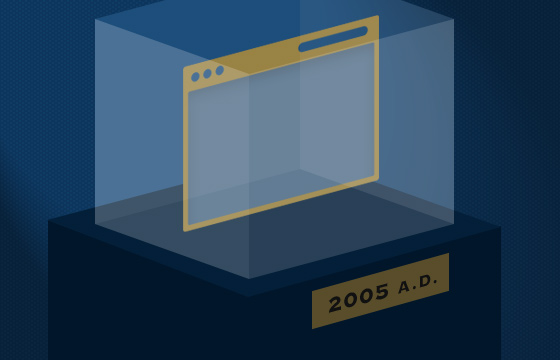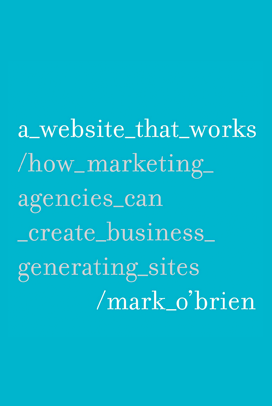Websites don’t last forever. Without consistent upkeep, sometimes they barely even make it three years! The rapid change of web technology can overtake what was once state-of-the-art and reduce a website to a quaint relic in pretty short order, which is why it’s so critical to realistically consider the “shelf life” of your website when you first build it.
But the truth is that predicting how technological change will affect your website is virtually impossible. There is bound to be something—whether it be the way browsers display your website or simply what’s in style—that will change in the near future and cause you to rethink choices you may be making right now. And that’s ok, as long as you’re comfortable with your website being a work in progress.
Meanwhile, for many existing websites, the signs of digital decay are accumulating. Dormancy has been a very common strategy for reducing web-related expenses during the economic downturn, but there really is no such thing as true dormancy. As the web around it continues to grow, an unmaintained website is subject to a similar entropy as an untended home—a crumbling foundation, peeling paint, leaks, and pests.
If that sounds like your website, keep reading. In this article, I’ve identified ten very good reasons to rebuild it…
If your website is three years old or more, you’ve probably done maintenance on it already. But if you haven’t, it’s likely that at least one of the points below applies to you and that you should begin planning a reboot…

1. Your business goals have changed.
It’s nice to start off with a short one. It’s so simple and obvious, but still needs to be said: Business goals change, and if you’re going to have a website that accurately reflects the nature of your business, it needs to be as current as your latest business plan. In fact, I’m still surprised when I speak to a website owner who describes an entirely different business to me over the phone than the one I’ve read about on their website.


Image by Justin Kerr
2. Your site was optimized for now-obsolete browsers.
If your website was built five years ago, there is a very good chance that some aspect of it is dysfunctional or perhaps even completely invisible to many of today’s web users. Conversely, if your website was built within the last year or so, it’s likely that without a lot of patience and work, it doesn’t function properly or look right in older browsers, even though many people still use them. Actually, looking at browser optimization in the reverse—in terms of optimizing today’s sites for yesterday’s browsers—might be a more helpful way of illustrating this point.
Browser optimization used to be the greatest lament of the web developer, as significant differences occurred between versions. But general web standards ushered in a time of comparative stability—one during which a three-year-old website could conceivably still work and look great on the latest version of Firefox. Today, even with at least four big players in the browser space, that stability is undermined by the continued use of IE 6. Released almost a decade ago in 2001—2 years before the first version of Safari, 3 years before the first version of Firefox, and 7 years before the first version of Chrome—IE 6 is like the ant of web browsers. It’s not smart, but it’s a survivor and has managed to spread…everywhere. (I wanted to compare it to the Borg, but the resistance of developers everywhere is not futile!) But back to the problem: Because IE 6 does not support CSS version 2, web developers have to create hacked versions of websites’ CSS files that divert from web standards in order to ensure that they function (fingers crossed!) in IE 6. This kind of thing is like time-traveling back to the 10th century with all the equipment to create a mini electrical grid just so you can plug in a lamp. So if we have to do all this work to get current websites to work right on outdated browsers, you can see why a website created when they were current would be a busted eyesore today!

3. Your site relies too heavily upon Flash.
We’ve been pretty consistently anti-Flash for many years now. The main objection to Flash as a web-development technology was that its architecture prevented sites built with it from being indexed by search engines. But today, Flash files can be indexed by search engines if properly optimized. But what about all those Flash websites from a few years ago? You know, the ones that made you watch a “Loading…” animation, reshaped your browser, started playing pulsing techno music and emanated all kinds of blips and ticks every time you rolled over links? Riiight, those sites. Those are still very, very bad. They’re still virtually invisible to search engines because they weren’t created with those new search-engine-friendly Flash settings, and frankly, they’re just downright annoying. And irritating a prospect is not a great way to begin a business relationship, is it? It’s actually rather shocking that sites built this way are still being launched in 2010. Perhaps if we referred those responsible for such sites as “Flashers” they’d stop?
Oh, and by the way, even though Flash has been adapting its architecture to search engines and is often used to facilitate individual features (i.e. slideshows, videos, and navigation menus), it’s still public enemy #1 to Apple’s mobile platform, so if you care at all about iPod touch, iPhone, and iPad users being able to access or use your Flash or Flash-enhanced site, consider rebuilding it as soon as possible.

4. Your site is unusable on mobile devices.
I may have gotten a bit carried away with my anti-Flash attitude in the last section, but this one is serious. The growth of the mobile industry is unprecedented and will certainly impact your business even in the next few years. Since Apple’s mobile platform devices first launched, over 120 million people have signed up for service. Apple expects over 100 million iPhone subscribers alone by the end of 2011. By 2012, an inflection point is anticipated at which time the number of active smartphones will exceed the total number of personal computers in the world. Soon, mobile will no longer be a peripheral web platform. It will be the primary one. In the meantime, the technological change within the mobile space is in rapid flux. Without beginning the process of acclimating your web presence to the mobile platform now, you are likely to experience a much more difficult transition later.

5. You cannot execute your content strategy with your existing website.
Most B2B marketing websites rely completely upon content-driven pull marketing. Clearly, if you know you need to change your digital marketing strategy to lead with web content and are hindered by an outdated website, you need to start there. But perhaps you built your last website around a content strategy that has proven ineffective. Now, after evaluating the failure of your PDF-filled resource library to attract interest, or your offsite blog to deliver valuable traffic to your main hub, you know you need your site to be a centralized repository for frequently updated, written, indexable, engageable content. To make that happen, it’s likely you’ll need to start from the bottom up, making sure that every aspect of your site functions in accord with its new purpose.

6. Your database has exceeded the scale for which it was built.
I’ll be honest, this one is a bit esoteric, but a much more frequent reason for a website rebuild than you might think. Let’s say you were ahead of the curve and your website allows you to do all kinds of things that a modern marketing website should: You can add new pages with ease, even build entirely new sections with multiple sub-levels. You’ve been adding weekly news items consistently. You’ve created 5 or 6 case studies every year. You’ve published 4 or 5 blog posts a week, consistently, many receiving ample comments. You have several calls to action and receive far more form submissions than you ever thought you would. You’ve been writing multi-page monthly newsletters since you launched. If your site is a few years old, that kind of activity is likely expanding your database exponentially. That kind of growth is great, but if your site was built (at the code level, mind you) with much more modest goals expected, it could actually be creating a significant performance and reliability problem. While it’s possible that the site could be reconfigured to account for the change in scale, it’s likely that the work required to tune it up would be more than rebuilding from scratch and importing your legacy content. While this is certainly not likely to be the most common reason for a rebuild out there, I’ve seen it enough times to include in this list.

7. Your site does not generate leads.
What is your website for? Hopefully you’ve discovered recently that your website’s primary function should be to provide compelling information to people and routinely generate qualified leads as a result of their interest. If your site’s only point of engagement is a generic “Contact Us” form, you’ve got a lot of work to do. If you dedicate some time to developing personas for your website, you’ll likely begin to see how their influence will reach all the way to its core and demand that you rethink and rebuilt it from the ground up. As soon as the prospect becomes part of the website planning process, it’s as if you have a real, live, new member of your web team who’s influence cannot be ignored.

8. Your site suffers from Frankenstein Syndrome.
Many companies make large investments in their websites with the false expectation that it’s a one-time expense. But as technologies rapidly change, forcing their own expectations for how the website fits in to their operation to change as well, they try to manage that change as inexpensively as possible. Sometimes that isn’t very visible to the user, but for the marketing team managing the site who may have to keep track of many third-party plugins and free tools, numerous data repositories, and the overall instability of an ad hoc digital marketing scheme, the inefficiency is very visible. However, this kind of expansion often does have a significant impact on the user experience and appearance of a website. It can range from the kind of information architecture sprawl that turns once orderly websites into a post-apocalyptic Los Angeles, to the even more common “just tack it on” phenomenon that makes web-pages look like a two-dimensional Times Square, with numerous blinking features all demanding equal user attention with no sense of hierarchy or order among them. No matter which clever metaphor applies to your situation, the point is that sometimes a refresh is just what is needed to ensure that your website portrays a unified voice and supports the best experience for users.

9. You cannot edit your current site.
Enough said. You need to have control over your site’s content. If you don’t, you need to have a plan to get it.

10. Your expectations for what a website should cost are not in line with what you expect it to do.
This one is a bit harder to describe, but I see it over and over again. In it’s most drastic form, it’s the type of disconnect that happens when a company’s first website is built by an executive’s nephew, setting a precedent for website and related budgets dwarfed by the growing reliance upon it to enhance and enable the company’s overall success. If a company expects profits in the millions but only paid $500 for their website, something is very wrong. Conversely, a $500 website is not likely to be an effective or reliable platform for a company of that size.
But it’s more common form is also more understandable, especially in light of the economic downturn that began in 2008. Many companies were forced to reduce spending in any possible way, shelving redesigns, functionality expansion plans, even needed maintenance and put many websites into operational and expense dormancy. But for most companies, prolonged web dormancy is not realistic. The longer a company gets used to a balance sheet lightened by web budget cuts, the harder it is to return to allocating a budget commensurate with expectation. In fact, most companies hope that expanding web capabilities will stimulate the rebound they so desperately need, but without an adequate budget to fund that expansion, those hopes are not realistic.

Discouraged? Don’t be. These issues are bound to happen to any website, particularly if left alone for too long. The good news is that none of them are unsolveable. If you’d like to discuss a particular problem with your site or get some more information about what rebuilding it would look like, drop us a line!



